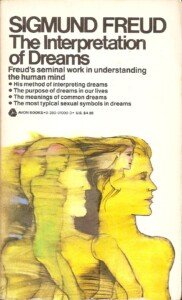Freud was careful to distance his method of dream interpretation from popular methods.
Dreams do have meanings
The science of Freud’s time regarded dreams as meaningless.
The theory that dreams are just random by-products of the brain’s functioning during REM sleep is still maintained by some scientists today.
It is also the theory we sometimes invoke to reassure ourselves when a dream has overwhelmed us with its meaning: ‘It was only a dream!’
For Freud, every dream is meaningful, no matter how nonsensical it seems or how little of it we remember.
There is no ‘dream dictionary’
A popular approach to dreams is to interpret them with the help of a fixed dictionary of symbols:
‘If you dream of X, it means Y.’ A house represents your mind, flying represents ambition, and so on.
This is often assumed to be central to Freud’s theory of dreams. But in fact, Freud undermined this naive theory of symbolic equivalences.
All dream elements are ‘symbolic’, but they have private meanings that can only be discovered through the dreamer’s associations.
Freud’s method for interpreting dreams was very simple.
I must affirm that dreams really have a meaning and that a scientific procedure for interpreting them is possible.SIGMUND FREUD
Instead of telling his patients what he thought their dreams meant, he invited them to say whatever came to mind in relation to each element of the dream, following their own trains of thought.
He encouraged them to relax their critical faculties, and to refrain from holding back thoughts that seem unpleasant, trivial or ridiculous.
He called this method free association.
The method of free association led Freud to the conclusion that dreams are the disguised fulfilments of repressed infantile wishes

